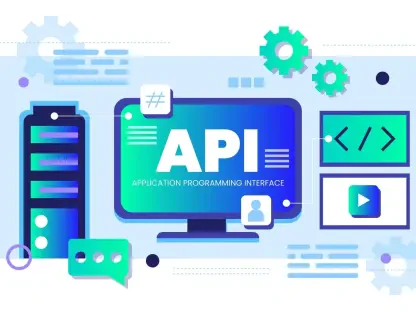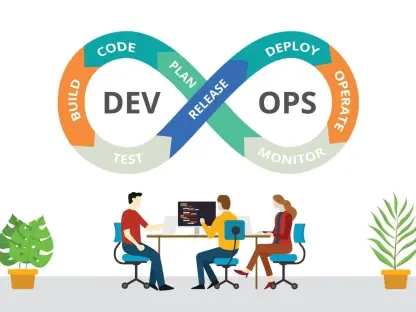Setting the Stage for DevOps in Today’s Enterprise Landscape
In an era where digital transformation dictates competitive advantage, enterprises face mounting pressure to deliver software at unprecedented speeds while maintaining reliability and security. A staggering statistic from Gartner reveals that by 2027, nearly 80% of organizations will embed a DevOps platform at the core of their delivery ecosystems, signaling its pivotal role in modern IT strategies. This rapid shift underscores a critical need for large-scale businesses to rethink fragmented workflows and embrace a unified approach to software development and operations. The stakes are high, as failing to adapt risks falling behind in a market that rewards agility and innovation.
This report delves into the transformative power of DevOps for enterprises, examining its evolution from a niche concept to a cornerstone of digital strategy. It explores the tangible benefits, persistent challenges, and actionable roadmaps that can guide organizations toward successful adoption. With industry giants paving the way and market projections pointing to near-universal integration, understanding DevOps is no longer optional but essential for survival in a fast-evolving technological landscape.
Understanding DevOps: A Necessity for Modern Enterprises
DevOps stands as a critical pillar in the current enterprise IT environment, fundamentally reshaping how software is built, tested, and deployed. It represents a cultural and technical movement that bridges the gap between development and operations teams, fostering seamless collaboration and accelerating delivery cycles. This integration eliminates traditional silos, enabling businesses to respond swiftly to market demands and customer expectations.
The journey of DevOps began as a response to inefficiencies in software delivery, evolving over time into a foundational strategy for digital transformation. What started as small-scale experiments in select tech firms has now become a mainstream approach, driven by the need for speed and reliability in complex IT ecosystems. Its adoption reflects a broader shift toward automation, transparency, and shared responsibility across organizational functions.
Prominent industry leaders such as Amazon, Google, and Netflix were among the early adopters, demonstrating the potential of DevOps to revolutionize operational efficiency. Their success stories, coupled with Gartner’s projection of 80% adoption by 2027, highlight its significance in enabling enterprises to achieve faster time-to-market and enhanced product quality. As digital demands intensify, DevOps emerges as a non-negotiable element for maintaining competitive edge and operational resilience.
The Case for DevOps: Key Benefits for Large Enterprises
Transformative Advantages of DevOps Adoption
One of the most compelling reasons for enterprises to adopt DevOps lies in its ability to optimize costs through automation and smarter resource allocation. By reducing manual interventions and standardizing processes, organizations can redirect efforts from repetitive tasks to strategic innovation. This shift not only lowers operational expenses but also enhances the efficiency of IT infrastructure management.
Scalability is another cornerstone benefit, particularly for enterprises operating across diverse teams and geographies. DevOps establishes consistent practices that ensure uniformity in delivery, regardless of location or regulatory constraints. Such standardization allows global teams to operate under a unified framework, minimizing discrepancies and ensuring predictable outcomes in software releases.
Beyond technical gains, DevOps catalyzes a cultural transformation toward continuous innovation and iterative progress. It redefines software development as an ongoing cycle rather than a series of isolated projects, empowering teams to experiment and refine solutions rapidly. This mindset fosters adaptability, enabling enterprises to introduce new features and updates in weeks rather than months, thus staying ahead of market trends.
Measurable Outcomes and Performance Metrics
The impact of DevOps on enterprise performance is quantifiable through improved deployment frequency and reduced cycle times. According to recent Gartner insights on DevSecOps adoption, organizations leveraging these practices have reported significant accelerations in software delivery, with many achieving multiple deployments per day. Such metrics underscore the efficiency gains that directly translate to competitive advantages.
Additionally, DevOps enhances operational oversight and strengthens risk management capabilities. Unified visibility across delivery pipelines allows teams to detect and resolve issues proactively, leading to fewer unplanned outages and faster incident response. Gartner data indicates that nearly two-thirds of DevSecOps adopters experience reduced security incidents and improved compliance, reflecting the value of integrated monitoring and control.
These measurable outcomes highlight how DevOps not only boosts speed but also fortifies reliability and security. Enterprises adopting these practices gain a clearer understanding of their systems, enabling better decision-making and resource prioritization. As a result, they can mitigate risks more effectively while maintaining alignment with regulatory and business requirements.
Challenges in Enterprise DevOps Implementation
Cultural barriers often pose the first significant hurdle in DevOps adoption, particularly the entrenched “Ops versus Dev” mindset that fosters division between teams. This friction, rooted in differing priorities—speed for developers and stability for operations—can delay progress and create inefficiencies. Addressing this requires deliberate efforts to align goals through joint planning sessions and shared metrics, gradually dismantling silos and building mutual trust.
Technical challenges also loom large, especially when transitioning from legacy monolithic systems to modern microservices architectures. These older setups, often rigid and cumbersome, hinder agility and make updates risky. A pragmatic solution involves incremental modernization, breaking down systems into smaller components and leveraging containerization to enhance flexibility. This phased approach reduces disruption while paving the way for scalable, manageable environments.
Organizational issues, such as unclear ownership over releases, further complicate implementation. When responsibility is fragmented, accountability suffers, leading to delays and confusion during production issues. Establishing a shared responsibility model, where developers and operations collaborate throughout the release cycle, can resolve this. Encouraging joint involvement in deployments and incident reviews fosters a sense of collective ownership, ultimately improving delivery speed and team cohesion.
Building a DevOps Culture: Governance and Compliance
Effective governance forms the backbone of a sustainable DevOps culture, ensuring clarity in permissions, audits, and access controls without stifling innovation. A lightweight yet robust structure is essential to define who approves changes and how code progresses through environments. Such frameworks prevent chaos as DevOps scales, maintaining order while supporting rapid delivery across enterprise teams.
Embedding DevSecOps practices is equally vital, integrating automated security and compliance checks into the pipeline to minimize friction. These mechanisms allow for continuous monitoring and vulnerability scanning, ensuring that security is not an afterthought but a core component of development. By automating these processes, enterprises can uphold stringent standards without sacrificing the pace of innovation.
Leadership plays a pivotal role in cultivating this collaborative culture, aligning DevOps initiatives with overarching business objectives. Executives must champion transparency and shared goals, encouraging teams to prioritize collective success over individual achievements. This top-down support helps embed DevOps as a strategic asset, ensuring that cultural transformation and technical advancements progress hand in hand toward long-term value creation.
Roadmap to Successful DevOps Adoption
A structured, phased approach is crucial for effective DevOps integration within an enterprise. Starting with a pilot project allows organizations to test practices on a small scale, identifying early wins and challenges. From there, standardizing processes across teams, scaling through platform engineering for self-service tools, and ultimately institutionalizing DevOps as a core cultural element ensures sustainable growth and alignment.
Actionable steps include adopting a DevOps mindset that prioritizes collaboration over mere automation, assessing infrastructure needs to tailor solutions to specific business goals, and selecting tools that integrate seamlessly with existing systems. Continuous feedback loops are critical, enabling iterative improvements through regular post-deployment reviews and open discussions. Additionally, investing in training ensures teams are equipped to navigate new workflows and embrace evolving responsibilities.
Measuring progress through key performance indicators, such as DORA metrics—deployment frequency, lead time for changes, change failure rate, and mean time to recovery—provides tangible benchmarks for success. These metrics guide conversations around bottlenecks and achievements, transforming data into actionable insights. Coupled with a focus on cultural transformation, this roadmap positions enterprises to build resilient, agile delivery systems that drive consistent value.
Future Trends Shaping Enterprise DevOps
The evolution of DevOps is increasingly influenced by AIOps, which introduces autonomous delivery pipelines capable of anomaly detection and self-healing mechanisms. This technology shifts the focus from manual oversight to intelligent optimization, predicting failures before they occur and streamlining deployment processes. As enterprises adopt these systems, operational efficiency and reliability are expected to reach new heights.
Platform engineering and Green DevOps are also gaining traction, with the former simplifying developer experiences through unified internal platforms and the latter emphasizing sustainability in cloud pipelines. Meanwhile, serverless and edge computing redefine speed and scalability by enabling real-time processing and simplified deployments. These advancements promise to make DevOps more accessible and environmentally conscious, aligning with broader organizational priorities.
Another notable trend is the rise of value stream management (VSM), which prioritizes business value over mere deployment speed, alongside cross-enterprise collaboration through multi-vendor ecosystems. These developments encourage secure integration of third-party solutions, fostering innovation across complex networks. Together, these trends signal a future where DevOps becomes a quiet, reliable foundation for digital ecosystems, balancing intelligence, sustainability, and interconnectedness.
Reflecting on DevOps as a Catalyst for Enterprise Growth
Looking back, the exploration of DevOps adoption revealed its undeniable impact on enterprise agility, efficiency, and innovation throughout various industries. The journey through its benefits, challenges, and strategic roadmaps underscored a powerful truth: success hinges on cultural alignment as much as on technological implementation. Enterprises that tackled silos, embraced governance, and measured progress with precision saw transformative results in their delivery capabilities.
As a next step, organizations are encouraged to initiate their DevOps journey with small, focused pilots, prioritizing cultural shifts over tool-centric approaches. Partnering with experienced consultants, such as those at Appinventiv, offers tailored guidance to navigate complex transitions. These collaborations help in crafting customized frameworks that align with unique business realities, ensuring sustainable outcomes.
Beyond immediate actions, the insights gained point to a broader consideration for the future—building digital resilience through continuous adaptation. Enterprises are urged to stay attuned to emerging trends like AIOps and Green DevOps, integrating them thoughtfully to maintain a competitive edge. This proactive stance promises not just survival, but leadership in a market defined by relentless technological evolution.









